1893 “Dover Demon”
Posted by: Loren Coleman on July 27th, 2009
1893 “Dover Demon”
© Loren Coleman 2009
Does the above image look familiar to you? It certainly does to me. It resembles the drawings of the Dover Demon seen in Dover, Massachusetts, from April 1977. However, it actually is from a newspaper article published in New York City on December 3, 1893.
This drawing was discovered by Robert Schneck (the author of The President’s Vampire) and shared with me, of course, because of my foundation interest in the Dover Demon. My appreciation to Schneck for bringing this to my attention.
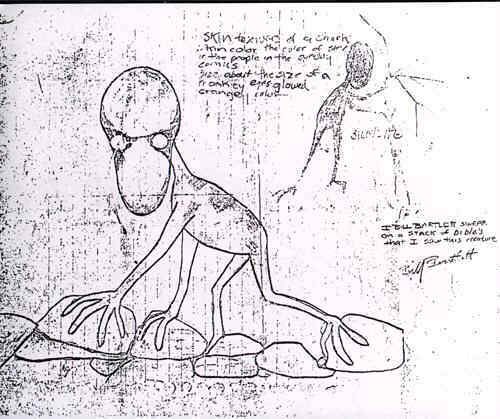
One of Bill Bartlett’s early sketches of the Dover Demon, April 1977.
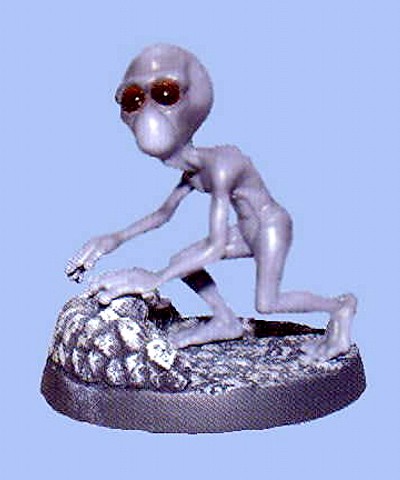
A modern replica of the 1977 Dover Demon sold in Japan.
The 1893 drawing is not of a sighting of any creature, however, but an artist’s (perhaps humorous) imagined illustration of how humans might appear in the future, viewed from the Victorian era. Specifically, the work is tied to the fictional writings of H. G. Wells and his little-known article, “The Man of the Year Million.” It is Wells who has predicted the future of humans will see a diminishing of their hair, nose, teeth, ears, and chin. The above 1893 drawing appears to be an attempt to capture Wells’ thoughts in a bit of newspaper art.
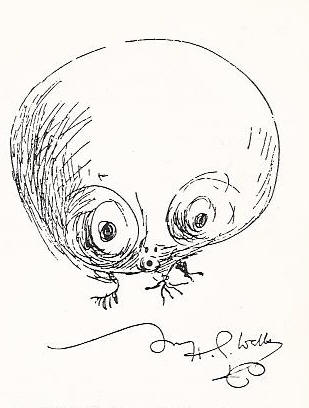
Elsewhere, H. G. Wells’s own sketch of the Man of Tomorrow was once drawn as an autograph. Credit David Szondy.
It is a sad commentary that as a reflection of the man of today, near the 1893 Dover Demon-like drawing, Schneck also found an image from an ad about paid (10¢) viewings of a “wild hairy man.” This was obviously an indigenous person (perhaps from Oceania) in an entertainment sideshow.
Back to the future…
As you may recall (see here from 2007), I remember from the 1950s and 1960s articles on “future humans” that were illustrated with (usually) bald men, the supposed picture of evolved Homo sapiens.
Future men?

Future man? = blogger author ufologist Nick Redfern.
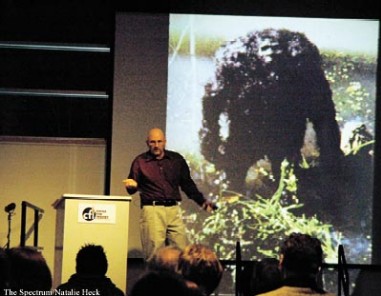
Future man? = debunker editor skeptic Ben Redford.
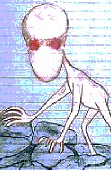
A colored Bill Bartlett drawing of the Dover Demon, 1977.
It is funny to me that Schneck would find this remarkable drawing from 1893, and it would nicely match the drawings that the eyewitnesses had sketched of the Dover Demon in 1977. I am not certain the 1893 treatment mirrors any future version of humans, however.
Please, also, let me be straight. I’m not saying anything about any space-time link between 1893-1977, or time travelers from the future journeying “back” to 1977 Dover. I merely think it’s an interesting coincidence and an outstanding find on Schneck’s part.
While I still maintain that the four eyewitnesses actually saw something extraordinary in 1977, which cannot be explained by mundane species, I do not know what the Dover Demon was or is. It remains the most unusual of the unexplained unknowns in my files of Fortean creatures, which appear to overlap into cryptozoology. After all, the Dover Demon is a cryptid, an unknown animal, apparently, seen in rather normal settings of rural Massachusetts.
The 1893 article…
Robert Schneck has painstakingly transcribed the news item and writes, “The article is hard to read but it’s written with heavy-handed humor that presumably went over big in 1893.”
The World, New York City, New York, December 3, 1893.
MAN IN THE YEAR MILLION
———
Look at the Picture Below and You Will See What the Human Race Is Coming To.
———
AN INORDINATE CASE OF SWELLED HEAD.Somebody in the Pall Mall Budget has let his fancy take wings in the contemplation of the time when all of the _____ _____ in these United States will be anything but humanity.
This ______ ‘s theme is the “Man of the Year Million.” And, judging from the accompanying picture, it will take about that long to complete the change. There is comfort in the thought that there is some little time ahead for good-looking fellows.
In his introduction this writer says: “Accomplished literature is all very well in its way, but much more fascinating to the contemplative man are the books that have not been written. These latter are no trouble to hold; there are no pages to turn over. One can read them in bed on sleepless nights without a candle.”
One of the unwritten volumes is a big book by Prof. Holzkopf, of the University of Weissnichtwo, on “The Necessary Character of the Man of the Remote Future. Deduced from the Existing Stream of Tendency.”
Just as the bird is the creature of the wing, and is moulded and modified for flying, so man is a creature of brain, and must live by that and not by physical strength. Naturally, then, that which is animal in him must gradually disappear as civilization more and more, becomes a fixed habit. He doesn’t need big muscles to get a living; nor big jaws to seize his food and crush it. His jaws get smaller, his teeth and hair are soon lost; trains and trolley cars render speed unnecessary; he doesn’t have to hunt his wife. She hunts him. Wit, and not strength. Is what he needs. Hence the legs will shrink up and the head swell.
Science gives him the knife and fork. There is no reason why it should not masticate and insalivate his food. Does it now digest it with all the pepsin compounds? Teeth will disappear.
The eyebrow used to be a buffer to protect the eye from savage blows. Once exterminate football and the ridge of bone over the eye will go the way of the hair on the pate.
In some of the most highly developed crustaceans, the whole alimentary canal has solidified into a useless cord, because the animal is nourished by the food in which it swims. The man of the year million will not be bothered with servants handing him things on plates which he will chew, and swallow and digest. He will bathe in amber liquid which will be pure food, no waste matter assimilated through the pores of the skin. The mouth will shrink to a rosebud thing; the teeth will disappear; the nose will disappear-it is not nearly as big now as it was in savage days-the ears will go away. They are already folded up from what they were, and only a little tip fast vanishing remains to show that ages ago they were long-pointed things which bent forward and backward to catch the sound of approaching enemies.
But the brains grow, for they are exponents of the brain, and the great soulful eyes.
Prof. Holzkopf goes on to that gloomy time when all animal life shall have been superseded by mechanical contrivances, on to the time when the earth cools and the human tadpoles burrow in the earth for warmth.
But the year million is far enough away, isn’t it?
© Loren Coleman 2009 (when noting this discussion, also please mention the discoverer of the 1893 illustration, Robert Schneck, the author of The President’s Vampire).
About Loren Coleman
Loren Coleman is one of the world’s leading cryptozoologists, some say “the” leading living cryptozoologist. Certainly, he is acknowledged as the current living American researcher and writer who has most popularized cryptozoology in the late 20th and early 21st centuries.
Starting his fieldwork and investigations in 1960, after traveling and trekking extensively in pursuit of cryptozoological mysteries, Coleman began writing to share his experiences in 1969. An honorary member of Ivan T. Sanderson’s Society for the Investigation of the Unexplained in the 1970s, Coleman has been bestowed with similar honorary memberships of the North Idaho College Cryptozoology Club in 1983, and in subsequent years, that of the British Columbia Scientific Cryptozoology Club, CryptoSafari International, and other international organizations. He was also a Life Member and Benefactor of the International Society of Cryptozoology (now-defunct).
Loren Coleman’s daily blog, as a member of the Cryptomundo Team, served as an ongoing avenue of communication for the ever-growing body of cryptozoo news from 2005 through 2013. He returned as an infrequent contributor beginning Halloween week of 2015.
Coleman is the founder in 2003, and current director of the International Cryptozoology Museum in Portland, Maine.

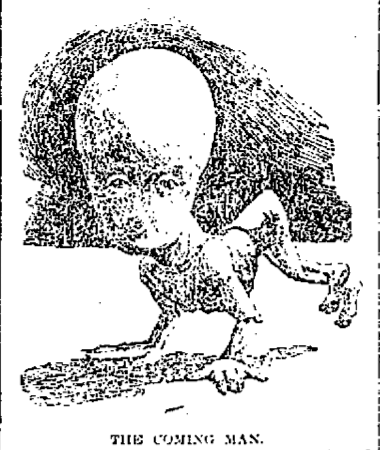
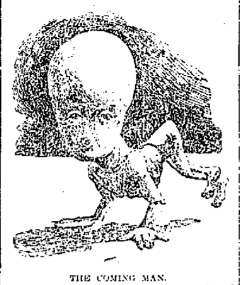









Hmmm, could this also be a link to the common description of a “grey alien”? If such a creature were circulated in print in the 1890’s it’s not out of the realm of possibility that it would have been the catalyst for grey alien descriptions of the last century.
Ah-ha….I’ve always known that Nick Redfern is different, I just didn’t realize how much, LOL (and my husband sports a Kojak as well….)
Raisinsofwrath makes a compelling point. From a paranormal perspective, it’s speculated that we’re seeing these things/entities in forms relevant to our culture and times. For example, we have far fewer werewolf and leprechaun sightings these days, and with the dissemination of Darwin’s work, we began seeing hairy hominids in earnest instead. With the advent of significant space technology, we began seeing flying saucers and little green (or gray) men by the boatloads. Does make you wonder what the future holds….what’s next to see?
While I have my doubts as to the truth of this idea regarding the people of the future – for one, we’re getting taller, not shorter, and George Bush is a clear indicator that our ears are not shrinking – this is a rather amusing coincidence. Perhaps if the people of the late 1800s saw the Dover Demon, they’d think it was a time traveller? (If it’s an intelligent species, it would probably think them either insane or quite daft)
Loren, I too recall the ‘man of the future’ idea that persisted into the 60’s, of the enlarged cranium and the atrophied body. This is also seen in many of the depictions of ‘little green men’ from outer space, including a few times in the original Star Trek series (though they weren’t green there). One example in tv cartoons was ‘The Great Gazoo’ from the Flintstones. Also in comic books, you had the occasional villain of supreme intellect with the literal ‘big head’ syndrome. I feel all of those stem from Wells’ ideas about the ‘man of the future’, which had become somewhat ingrained into at least the science fiction community if not our culture as a whole.
Interesting juxtoposition, though, Loren, I agree. Thanks for passing this along.
On that track of early inspiration for the image of the “grey” in the public subconscious, we also don’t want to forget Crowley’s “Lam”.
The very first time I looked at this I said..”WOW”, then it was “Hmmmmm”
Yep, Looks like an Alien. Kinda cute in an eerie kinda way.
Kinda figured that they’d be here too ! ( here, as in regards to Earth.)
Actually, many folks I know of (and many Cree Indians, supposedly) consider The Dover Demon to be not an Alien but a fairy-type “TROLL” from their folklore called the Mannegishi. The creature bears a striking resemblance to the descriptions of the Demon given by Bartlett and the other witnesses.
The Mannegishi was a trickster figure who delighted in playing pranks, such as overturning canoes. The Ojibwa have the similar Memegwesi.
To be honest, I would not consider this to be necessarily “paranormal,” but as a creature that was/is mischievious and was considered by the Cree as a “Troll Being.” Does not mean it IS “trollish,” as in the sense of fairytales or “David The Gnome” Trolls, but as a creature that they knew/know of that is “devious,” like a Fox, let’s say.
If something like that would be detected by Science and verified, I wonder what we would classify it as? Who knows?
The Dover Demon has always been my personal favorite of the Fortean cryptids that I first read about via Loren’s earliest writings. And I find it highly interesting that some sort of historical evidence has been uncovered (that is, if I am reading this article correctly).
OK, I just read the article again and see that the images is not in fact a historical record of an earlier sighting, but rather, an artist’s impression of what the man of the future may appear like.
I’ve got to polish my reading comprehension skills, obviously. . .
Its gollum to a T ! A hobbit degraded by desire nature caught from its association with the power of the rings! Per Tolkeins, Lord of the Rings (1937).
Greetings All!
So according to H.G., we’re all going to turn into the little critter seen in Enfield, Illinois in 1973? 🙂 Hmmm. Could be worse I guess! Considering that we’ve been working on being “human” for about 200K years so far, in a million years we could go in almost any direction. Especially since we’re bound to not let nature take its course, but to meddle in it ourselves one way (genetically) or another (climate change)!
Interesting, fossilhunter, that you should pick out that Enfield, Illinois case from 1973. Although Weird Illinois doesn’t acknowledge it, that was my case investigation. It was much different than the Dover Demon, however, and was more like a combo phantom kangaroo, devil monkey, and swamp ape situation.
Regarding the grey aliens, I think that their appearance is determined by some sort of archetype interpreted in late 20th century terms. Whether this is because the beings behind the sightings choose to appear this way for some reason, or whether we cannot help but interpret them in this way, or whether “they” don’t have any separate existence from the minds of their witnesses, I’m not so sure.
I probably should be more explicit with what I mean. If the appearance of the greys is an archetype, it’s no surprise that artists may have used it a century ago.
I’m reminded of what a fun writer H.G. Wells is still, and how influential his writings are in the history of science fiction. I read his “The Invisible Man” a couple of summers ago and found it surprisingly fresh, given all the filmed versions of the story.
(My favorite IM movie: Abbott and Costello Meet the Invisible Man!)